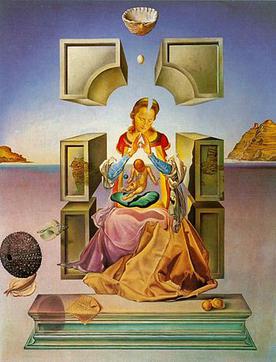The_Madonna_of_Port_Lligat
The Madonna of Port Lligat
Two paintings by Salvador Dali
The Madonna of Port Lligat is a pair of paintings by Salvador Dalí. The first was created in 1949, measuring 49 x 37.5 centimetres (19.3 x 14.8 in), and is housed in the Haggerty Museum of Art at Marquette University in Milwaukee, Wisconsin, USA. Dalí presented it to Pope Pius XII in an audience for approval, which was granted. Dalí created a second painting in 1950 with the same title and same themes, with various poses and details changed, measuring 275.3 x 209.8 centimetres (108.4 x 82.6 in). The 1950 Madonna is exhibited at the Fukuoka Art Museum in Japan.[1]
This article needs additional citations for verification. (March 2016) |
The paintings depict a seated Madonna (posed by Dalí's wife, Gala) with the infant Christ on her lap. Both figures have rectangular holes cut into their torsos, suggestive of their transcendent status. In the 1950 version Christ has bread at the center of his figure. They are posed in a landscape, with features of the coast of Port Lligat, Catalonia, in the background, with surrealist details including nails, fish, seashells, and an egg. The 1949 Madonna has a sea urchin; the 1950 Madonna has a rhinoceros and figures of angels, also posed by Gala.
